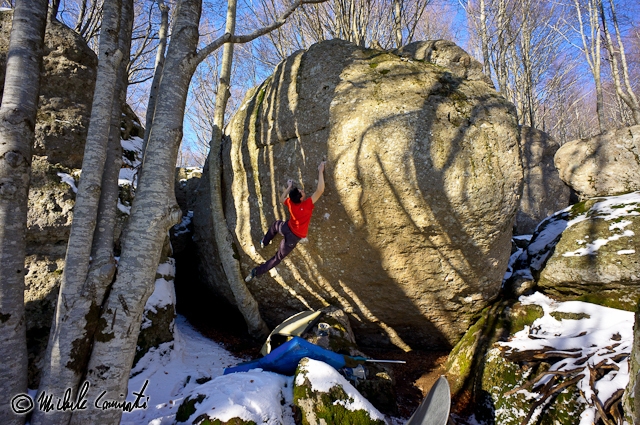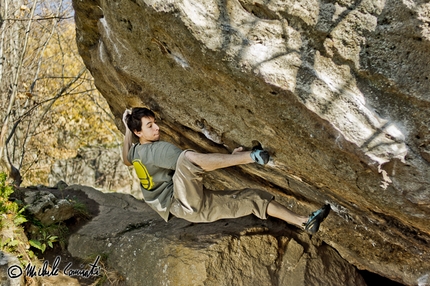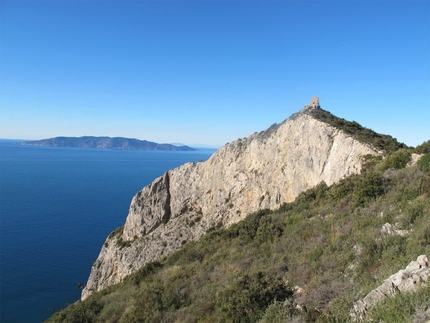
 1 / 16
1 / 16 Michele Caminati
Michele Caminati





The name Amiata probably derives from the Latin "Ad meata" i.e. "at the source" or, according to others, from Mons Tuniatus (subsequently Montuniata) i.e. Monte di Tunia, the most important Etruscan deity. This detail aside, the 1738 metre high dormant volcano is surrounded by lush chestnut and beech forests, is rich in wildlife, natural springs and great people and is most certainly an area which, if not sacred, is magical and highly fragile.
Climbers have long-known about the quantity and quality of the trachyte boulders, hidden from view and dotted almost everywhere across the slopes of this volcano, and currently there are circa 200 boulder problems. Less is known about the higher outcrops and although there are approximately 150 sport climbs developed above all by Bengio Chiesi, in reality Pandora's box was only recently opened by two of Amiata's most psychotic climbers (namely myself and Michele Caminati) who have discovered a great playground for trad climbing or, if you prefer, clean climbing. Truly unique, especially in Central Italy...
Due to its morphology the volcanic rock with its cracks and pockets is wonderfully suited to trad climbing with Friends and, in particular, tricams. Watch out though as some flakes and tafoni are fairly fragile... The slopes are littered with these outcrops and the surrounding chestnut groves, although on private land, can be accessed freely (except for the harvest time when they are strictly off-limits) if treated with the utmost respect, leaving them in better condition then as you find them. Only a minor portion of the area's trad potential has have been cleaned and repeated. Furthermore, it is also possible to repeat almost all existing sport climbs (from 4a to 7c/8a) as trad climbs. Given the uniqueness of this area, the local climbers have responded very positively to this new approach.
Amiata is located between the Maremma, Val d'Orcia, Val di Chiana and Lake Bolsena. It can be reached easily via the A1 motorway by exiting at Chiusi or via the Siena/Grosseto highway for those coming from the north.
ClimbThe most interesting areas are Catarcione and Sasso di Dante at Abbadia San Salvatore as well as Sasso Corbaio at Santa Fiora and, above all, Chiesina at Castel del Piano where the first clean routes were climbed.
NotesAs mentioned previously, please enter these woods on tiptoes and respect the environment. More than just trad climbing, the recent approach is "clean" which implies leaving absolutely no trace, neither on the paths nor on the trees nor on the rocks themselves, apart from brushing moss and lichens off the surface (the routes are new and therefore still fairly dusty). The name of the game here is creativity, adventure and the unknown combined so that future visitors can enjoy the same fun and amazement experienced by those who preceeded them.
| N° | Name | Height | Beauty | Difficulty |
|---|---|---|---|---|
| 1 | Aspettando Frida |      |
4+ | |
| placca + fessura | ||||
| 2 | Rito pagano |      |
5+ | |
| fessura obliqua + placca | ||||
| 3 | Chicken wing |      |
6a+ (E3 5c) | |
| diedro + fessura + placca | ||||
| N° | Name | Height | Beauty | Difficulty |
|---|---|---|---|---|
| 1 | Normale |      |
6a+ (E3 5c) | |
| fessura obliqua + muro verticale | ||||
| 2 | Un friend per amico |      |
7b (E6 6c) | |
| fessuretta + muro verticale | ||||
| 3 | Il nido del cinghiale |      |
6b (E3 6a) | |
| fessura strapiombante | ||||
 Comments
Comments








 Copia link
Copia link Federico Schlatter
Federico Schlatter













 See all photos
See all photos
